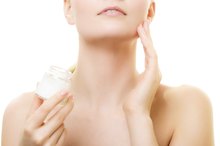Use of Glycolic Acid During Breastfeeding
The foods you consume and the products you apply to your skin can affect your baby when you are breastfeeding. Now that your heightened pregnancy hormones are beginning to diminish, it’s natural to want to return to your previous skincare routine. While you should always speak to your physician before using any topical products, those containing alpha hydroxy acids like glycolic acid are generally considered safe for use when you are breastfeeding.
Significance
Glycolic acid is a member of the alpha hydroxy acid family, which means glycolic acid is derived from fruit -- specifically sugar cane. Other examples of alpha hydroxy acids include malic acid from apples and citric acid from lemons and oranges. Glycolic acid is specifically used to encourage cell turnover and stimulate your skin to release dead skin cells from your face. Because it also can slough oily buildup in your pores, glycolic acid can treat acne as well. The acid is added to lotions, creams and gels and used in higher percentages for chemical peels, which are designed to intensify glycolic acid’s effects on the skin 2.
- Glycolic acid is a member of the alpha hydroxy acid family, which means glycolic acid is derived from fruit -- specifically sugar cane.
- The acid is added to lotions, creams and gels and used in higher percentages for chemical peels, which are designed to intensify glycolic acid’s effects on the skin 2.
Concerns
What Face Creams Are Unsafe When You Are Pregnant?
Learn More
Exercise caution when applying skincare products while breastfeeding because active ingredients can potentially absorb into your skin and pass into your bloodstream. Your baby does not have the developed immune system you do, so he is more likely to react negatively to certain ingredients in skincare products. For the most part, oral medications are considered to cause more severe effects than topical creams and lotions. The potential for side effects means you should be cautious.
- Exercise caution when applying skincare products while breastfeeding because active ingredients can potentially absorb into your skin and pass into your bloodstream.
- Your baby does not have the developed immune system you do, so he is more likely to react negatively to certain ingredients in skincare products.
Safety
In general, glycolic acid products are considered safe to use when you are breastfeeding, according to BabyCenter. Also note that manufacturers may list glycolic acid as simply AHA or alpha hydroxy acid for labeling purposes. In this instance, the skincare product is still considered safe for use. However, these products should not be confused with beta hydroxy acids, such as salicylic acid, that can potentially cause side effects when applied to the skin in large amounts.
- In general, glycolic acid products are considered safe to use when you are breastfeeding, according to BabyCenter.
Considerations
Scented Lotion While Breastfeeding
Learn More
Read the labels of all your skincare products to determine if they contain glycolic acid. Some body lotions can contain glycolic acid. In this instance, you should avoid applying the lotion to your nipple area to ensure your baby will not swallow the glycolic acid. Check with your physician before undergoing a glycolic acid chemical peel as these contain higher amounts of acids and are intended to penetrate the skin more deeply.
- Read the labels of all your skincare products to determine if they contain glycolic acid.
- Check with your physician before undergoing a glycolic acid chemical peel as these contain higher amounts of acids and are intended to penetrate the skin more deeply.
Related Articles
References
- BabyCenter; Safe Skin Care During Pregnancy; Angie Drakulich
- Johns Hopkins Medicine: Chemical Peels
- Kelly Mom; Can I Continue to Breasteed If...?; Kelly Bonyata, IBCLC
- "O, The Oprah Magazine"; Your Skin's New Best Friend; Jenny Bailly; July 2009
- National Institutes of Health PubChem. Glycolic acid. Updated February 1, 2020.
- Tang SC, Yang JH. Dual effects of alpha-hydroxy acids on the skin. Molecules. 2018;23(4):863. doi:10.3390/molecules23040863
- Fabbrocini G, Annunziata MC, D'Arco V, et al. Acne scars: pathogenesis, classification and treatment. Dermatol Res Pract. 2010;2010:893080. doi:10.1155/2010/893080
- U.S. Food and Drug Administration. Alpha hydroxy acids. Updated May 7, 2019.
- Al-Talib H, Al-Khateeb A, Hameed A, Murugaiah C. Efficacy and safety of superficial chemical peeling in treatment of active acne vulgaris. An Bras Dermatol. 2017;92(2):212–216. doi:10.1590/abd1806-4841.20175273
- Abels C, Reich H, Knie U, Werdier D, Lemmnitz G. Significant improvement in mild acne following a twice daily application for 6 weeks of an acidic cleansing product (pH 4). Journal of Cosmetic Dermatology. 2014;13(2):103-8. doi:0.1111/jocd.12086
- Kaminaka C, Uede M, Matsunaka H, Furukawa F, Yamomoto Y. Clinical evaluation of glycolic acid chemical peeling in patients with acne vulgaris: a randomized, double-blind, placebo-controlled, split-face comparative study. Dermatological Surgery. 2014;40(3):314-22. doi:10.1111/dsu.12417
- Sharad J. Glycolic acid peel therapy - a current review. Clinical Cosmetic and Investigational Dermatology. 2013;6:281-8. doi:10.2147/CCID.S34029
- Takenaka Y, Hayashi N, Takeda M, Ashikaga S, Kawashima M. Glycolic acid chemical peeling improves inflammatory acne eruptions through its inhibitory and bactericidal effects on Propionibacterium acnes. Journal of Dermatology. 2012;39(4):350-4. doi:10.1111/j.1346-8138.2011.01321.x
Writer Bio
Rachel Nall began writing in 2003. She is a former managing editor for custom health publications, including physician journals. She has written for The Associated Press and "Jezebel," "Charleston," "Chatter" and "Reach" magazines. Nall is currently pursuing her Bachelor of Science in Nursing at the University of Tennessee.









